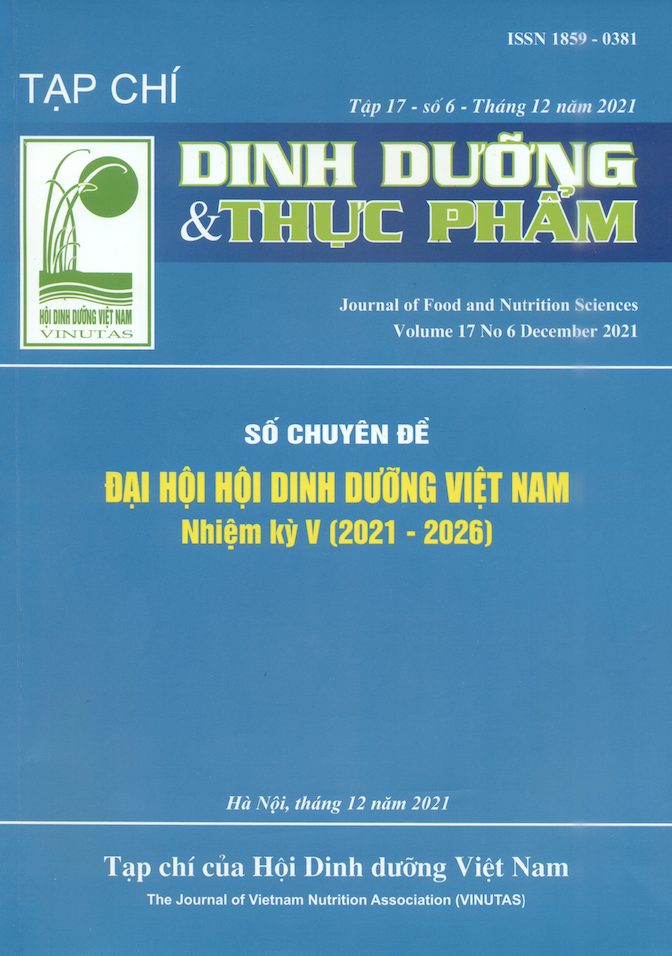Chronic energy deficiency and related factors of women of child bearing age in Vu Thu district, Thai Binh province in 2015.
Main Article Content
Abstract
Chronic energy deficiency causes many bad effects to women of child bearing age such as increased risk of infection diseases and reduced immune response resulting to slow recovery when getting sick. A cross-sectional descriptive study with systematic sampling among 548 women of child bearing age from 20 to 49 years old was con- ducted in Vu Thu district, Thai Binh province. Objectives: to describe the situation of chronic energy deficiency and related factors in the subjects. The anthropometrical results showed that average height was 152.7± 4.4(cm), and weight was 46.5 ± 5.3(kg), BMI was 19.9 ± 2.0(kg/m2). The prevalence of chronic energy deficiency in general, in level I, in level II and in level III was 20.4%, 14.1%, 3.8% and 2.6% respectively.
Women with low income, having more than 2 children, having acute diarrhea in the last two months, anemic, were at risk of chronic energy malnutrition (p<0.05). It is important to actively implement nutritional interventions for this group to compensate for the deficiencies in order to improve the health and well- being of the women and their offsprings.
Keywords
Women of child bearing age, chronic energy deficiency (CED), Vu Thu district, ThaiBinh province
Article Details
References
2. Viện dinh dưỡng, Unicef (2011). Báo cáo Tình hình Dinh dưỡng Việt Nam năm 2009-2010. Nhà xuất bản Y học Hà Nội.
3. Asmare Wubie, Omer Seid, Sisay Eshetie, et al. (2019). Determinants of chronic energy deficiency among non-pregnant and non-lactating women of reproductive age in rural Kebeles of Dera District, North West Ethi- opia. Unmatched case control study. PLoS ONE. 2020;15(10):e0241341.
4. Ilyas U, Kousar P (2019). Malnutrition and its Associated Risk Factors among Women of Reproductive Age in Rural Community of Lahore. International Journal of Medical Research & Health Sciences. 8(3):173-8.
5. Bộ Y tế - Viện Dinh dưỡng (2012). Chiến lược Quốc gia về Dinh dưỡng giai đoạn 2011-2020 và tầm nhìn đến năm 2030.
6. Nguyễn Anh Tú (2012). Hiệu quả sự dụng mì ăn liền từ bột mì tăng cường vi chất ở phụ nữ công nhân bị thiếu máu tại khu công nghiệp nhẹ của Tỉnh Vnh Phúc. Luận án tiến sĩ Dinh dưỡng, Viện Dinh dưỡng.
7. Shetty P.S. (1994). Body mass index - A measure of chronic energy deficiency in adults. Food and Nutrition 1994; Paper 56, FAO Rome.
8. WHO/UNICEF/UNU. (2001). Iron deficiency anemia, assessments, prevention and control: a guide for pro- grame managers. WHO/NHD/013, Geneva. 2001.
9. Nguyễn Quang Dũng (2015). Thiếu máu thiếu sắt ở phụ nữ tuổi sinh đẻ người H’Mông tại một số xã thuộc huyện Bảo Lạc, tỉnh Cao Bằng. Tạp chí Nghiên cứu Y học. 96(4), 107 – 113.
10. Trần Thị Hồng Vân (2020). Đánh giá hiệu quả giải pháp can thiệp bằng truyền thông giáo dục dinh dưỡng và bổ sung viên sắt trên phụ nữ độ tuổi 24 đến 35 tuổi người dân tộc tày tại một số xã huyện Phú Lương tỉnh Thái Nguyên. Luận án tiến sỹ trường Đại học Y Hà Nội.
11. Lê Minh Uy (2008). Tình trạng dinh dưỡng phụ nữ 15-49 tuổi tại An Giang. Tạp chí Dinh dưỡng và thực phẩm. 4(3+4):57-63.
12. Đinh Thị Phương Hoa (2013). Tình Trạng dinh dưỡng, thiếu máu và hiệu quả bổ sung sắt hàng tuần ở phụ nữ 20 - 35 tuổi tại huyện Lục Nam tỉnh Bắc Giang. Luận án Tiến sĩ Dinh dưỡng, Viện Dinh dưỡng.


